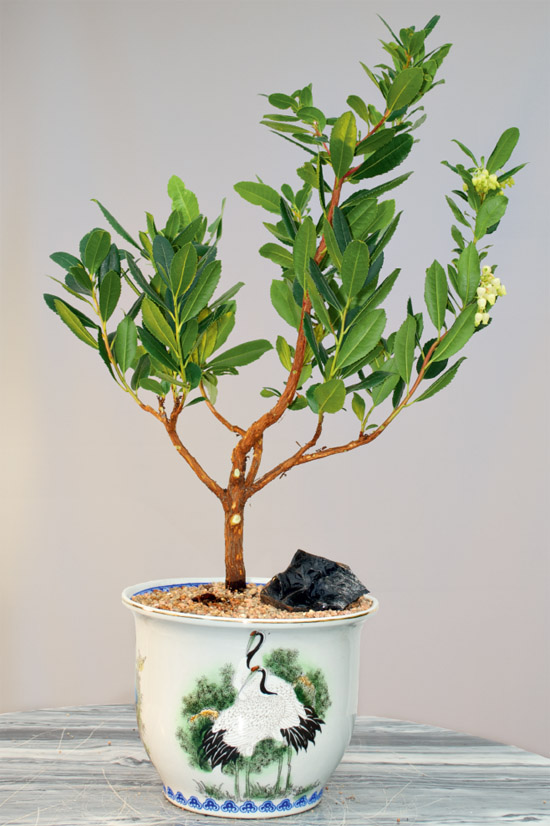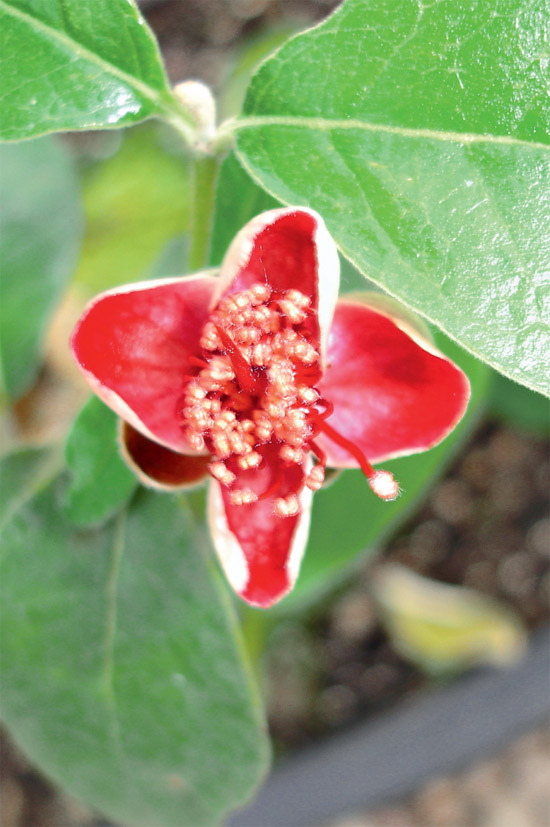

CHAPTER 6
The Bountiful Harvest
The main purpose of this book is to help you create bonsai that will bear a harvestable crop for home use. A small collection of bonsai can provide a surprising variety of flavors to add to your cooking. While I will include some specific recipes here, most of my personal bonsai harvest is used in two ways. I use small amounts to accent and add flavor to dishes I already make regularly. Herbs can be dried, and fruits can be frozen, lasting for a year or more to be used as needed. The various herbs and the small citrus that can be eaten peel and all, such as the calamondin orange, kumquat, and limequat, are especially useful in this way. A single fruit from these small citrus can be enough to flavor an entire dish. During the cold, snowy winters at my mountain home, my citrus bonsai carry enough ripe fruit to use in cooking every week; they are the most productive and useful specimens in my entire collection.
It is also possible to create long-lasting foods from your bonsai’s production. With a larger harvest, or by combining several small harvests saved by drying or freezing, there are several ways to preserve your bonsai crop for years. Small fruits can be canned in sugar syrup, or made into jams, jellies, or chutneys. These can then be used like the fresh fruit to flavor dishes. One batch of rosemary jelly canned in small jars can provide a continuous supply of unique, sweet rosemary flavor to use in the kitchen. My favorite way to preserve a bonsai harvest is to make wine that can be savored for years, or even decades. Herbs, flowers, and fruits from bonsai specimens have contributed to my wine cellar for more than twenty years.
Perhaps the simplest bonsai are the various herbs, which are highly productive. A single rosemary, thyme, sage, or savory bonsai can provide enough fresh and dried herbs to supply a household for an entire year. Pick the leaves fresh to chop and use as needed. When shaping your bonsai, dry the leaves for later use. If you enjoy grilling, save your herb stems, soak them in water, and throw them on the coals to flavor meats, vegetables or fruits. Basil doesn’t keep its flavor well when dried, but fortunately grows quickly enough to provide a nearly continuous fresh harvest. The best way to preserve an oversupply of basil is by freezing it. Put it in a blender with just enough water to whip it up into a thick green slurry, then freeze it in ice cube trays. These frozen basil cubes will keep their flavor for a year and are very useful in the kitchen: one cube will perk up any dish. Another way to preserve these culinary flavors is to make herbal jellies. Mint jellies are generally served with lamb, but rosemary jelly makes a wonderful glaze on roast turkey. Making herb jellies is as simple as brewing a strong tea and adding sugar and commercial pectin. Use a mint jelly recipe and substitute your favorite herb for the mint. Herbal jellies are delightful spread on toast or crackers, and can be added to glazes and sauces of all kinds. Tuck a fresh rosemary sprig into a jar of bonsai rosemary jelly before sealing to create a unique holiday gift.
Other fragrant plants such as lemon verbena, lavender, pineapple sage, Costa Rican mint, and scented geraniums are considered more useful as potpourri or herbal teas, but they all can be used in the kitchen to provide unique accents to dishes. Don’t be afraid to experiment with your herbs in new ways that aren’t covered in traditional cookbooks. Try substituting lemon thyme for regular thyme, or adding lemon verbena when preparing eggs with fresh herbs. Both rosemary and thyme make a stimulating hot tea on a cold winter morning. Soothing lavender tea can be made with foliage trimmings as well as the flowers of French lavender. Flowers such as hibiscus and jasmine, as well as the petals of any citrus flower, make great additions to herbal tea blends, or can be used to flavor green tea. Small citrus that are edible whole, like kumquat, limequat, and calamondin orange, can be sliced thin, dried, and chopped or crumbled to add to your tea blends. Herbs like pineapple sage, lemon verbena, and Costa Rican mint have intense yet very pleasant fragrances that are almost intoxicating when used as aromatherapy. One of my favorite uses for these herbs is to garnish a mixed drink or even lemonade with a fresh sprig that brushes the nose with every sip. Aromatherapy can be very beneficial even if it just brightens your mood and brings a smile to your face. If you have fragrant herbal bonsai, touch them and breathe in the fragrance every day. Don’t forget to stop and smell the flowers when your jasmine, myrtle, Natal plum, or citrus is in bloom.
Tea is nice, but sometimes a drink with a little more kick is desired. Dandelion wine is not the only flower wine—I have hibiscus-flower wine and jasmine-flower wine in my cellar. I’ve used a quart of jasmine per gallon and a couple quarts of dried hibiscus per gallon of wine to turn out these delicate vintages. Making flower wines essentially involves brewing a strong tea, adding sugar and wine yeast, and then waiting as your tea turns into wine. Adding raisins as part of the sugar gives the wine more body and character, and is especially helpful with flower and herb wines that don’t contain any other fruit. You’ll find winemaking supplies and detailed instructions at your local home-brewing store. Basic equipment includes a covered bucket for primary fermentation and a large glass bottle with a fermentation lock for secondary fermentation and aging.
I used four one-quart jars packed full of dried jasmine flowers, fifteen pounds of sugar, two pounds of golden raisins, and a packet of wine yeast to make two cases of jasmine-flower wine with the following recipe: Pour two gallons of boiling water over the flowers and chopped raisins, then add another gallon of water in which five pounds of sugar have been dissolved. When cool, add wine yeast. Stir twice a day. After several days, add another five pounds of sugar dissolved in water; after several more days, repeat once more. After ten to fourteen days of this primary fermentation, strain out the flowers and raisin pulp and pour the fermenting wine into a glass container, sealing it with a fermentation lock. You can use gallon jugs or five-gallon glass carboys from a home-brew store for this. Your wine will finish fermenting and start to age, and will be ready to drink or bottle in three to six months. This same recipe can be followed to make herbal wines, which are great for sipping and incredible when used in cooking.
I have been accused of being obsessed with winemaking. Admittedly, I am past the middle of a third decade of building a cellar containing several hundred cases of homemade wine. My cellar contains wines made from most of the edible bonsai discussed in this book. There are rosemary and thyme wines made from bonsai trimmings that have been aging in my cellar for more than twenty years; my oldest is a lavender wine from 1986. The artistic symmetry of drinking a decades-old wine made from a bonsai while viewing bonsai that have been in training that long is very appealing. I treasure my bonsai harvests, and the best way to preserve that harvest to enjoy for years is to make wines that can age along with the plants themselves.
Herbal and citrus wines can be intense, and are great served as an aperitif in small servings. For cooking, however, nothing else can compare. They can be used in sauces or marinades and splashed over any sauté. Use them to baste foods cooking on the grill, or as an ingredient in homemade salad dressing. My favorite way to prepare a turkey is to use one of those oven-baking bags and one to three cups of wine, depending on size, to steam it and infuse it with flavor. A chicken or any type of roast may be cooked the same way. The meat will be tender and juicy and the leftover liquid will make great gravy or soup stock.
Flower and fruit wines are more conventional and easier to drink a bottle of over dinner. As mentioned above, jasmine and hibiscus flowers can be dried and saved for making wine. Figs, guavas, and some citrus make heartier fruit wines. Mellow citrus like orange, blood orange, and even kumquat can make delightful wines by using a couple gallons of fruit with water, sugar, and wine yeast to make five gallons of wine. Sharper-tasting citrus like lemons, limes, and limequats make more intense wines, especially if a greater quantity of fruit is used per gallon of wine. My favorite cooking wine is made from lemon basil, lime basil, lemons, and limes fermented together. It’s a citrus explosion on the palate when sipped, and adds great flavor to any dish. One of my favorite tricks when cooking rice is to add half a cup of herbal wine to the rice for the last five minutes of steaming. This adds delightful flavor to steamed rice; different wines can be paired with specific main dishes to be served alongside.
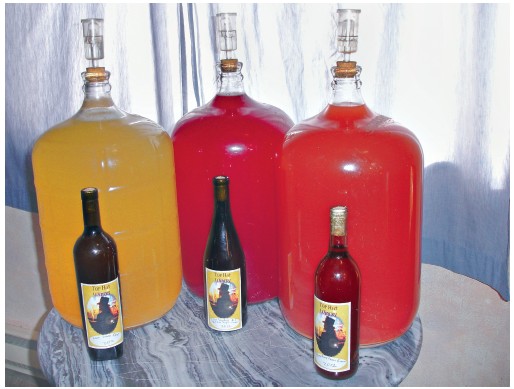
A few of my vintages: Lemon Lemon Drop, Citrus Symphony blend, and Strawberry Lemon Guava wine.
I never use sulfites, which are supposed to kill yeast and “preserve” wines, yet my vintages have lasted for decades and improved with age. In fact, an opened partial bottle kept corked in the fridge can be used for months without it going bad, making it possible to have several different cooking wines open for regular use in the kitchen to provide variety. Making wine is definitely my favorite way to preserve an edible bonsai harvest. It is not too difficult, and one five-gallon fermentation bottle on your counter can make two or three batches of wine a year. Learn to do this and you will have a unique supply of wines for cooking, drinking and special gifts.
The most prized and useful part of my bonsai harvest is the citrus. This is in part because I take pleasure in being able to produce a usable citrus crop in a colder northern climate. It is more difficult to produce large citrus like oranges or grapefruits indoors, but lemons and limes are easier, and the smaller limequats, kumquats and calamondin oranges can be extremely productive and are exceptional, peel and all—with seeds removed—for use in cooking. Key limes can also be used like this if sliced very thinly. Kumquats are smaller and you may need to use several for the same amount of flavor as one of the larger citrus. These intensely flavored fruits are sour, and may need to have sugar or honey added when used in desserts. They can be used to flavor yogurt or homemade sorbet and ice cream. Whole kumquats and quartered, seeded limequats or oranges can used as an edible garnish for mixed drinks.
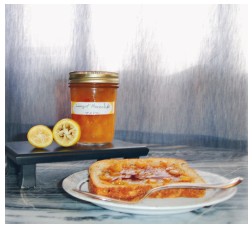
Limequat marmalade and toast.
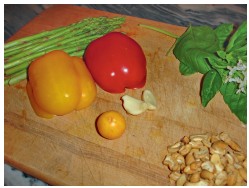
Ingredients for sautéed asparagus with peppers, basil, garlic, cashews, and calamondin orange.
The small citrus really shine in cooking, however. They can be used fresh, frozen, or canned; you can even use the pulp left over after fermenting into wine. Limequats and calamondins, which have sharply different flavors, make an intensely flavored marmalade to be spread on toast or added to any sauce that would benefit from that sweet-tart flavor. You can substitute the finely chopped, seeded fruits, plus a little added water, in any orange marmalade recipe that uses commercial pectin. Gently warm some marmalade with a splash of citrus or herbal wine, add spices if you like, and use as a final glaze on grilled meat or a roast bird. Rosemary or thyme would be good with this—or, for a unique twist, flavor the glaze with Chinese five-spice blend.
Small citrus are at their best used fresh. Any of them can be chopped and added to your favorite sauté or stir-fry. A simple favorite is to sauté asparagus with almonds and garlic in olive oil, then chop a seeded calamondin orange and add with the garlic. You’ll get a nice citrus note with the asparagus and a sharp citrus burst when you bite into a piece of peel. Chopped, seeded citrus can also be added to eggs in an omelet, scramble, or soufflé. Try onion, garlic, celery, red pepper, cashews, mushrooms, and a limequat for a lively combination. The bright flavor that comes with the citrus enhances everything.
A dish I like to take to parties is a Salmon Citrus Cheese Ball. In olive oil, sauté onion, garlic, ginger, celery, bell peppers (red, yellow, and green), one hot pepper, cashews, parsley, and two chopped, seeded limequats or calamondins. Add about four ounces of flaked salmon (you can also use crab or chopped shrimp). Splash in some herb or citrus wine with the seafood and finish the sauté. Stir the resulting three to four cups of sautéed veggies and salmon into a package of cream cheese while still hot, then chill and roll into a ball. Roll the cheese ball in crushed nuts if you like. If you don’t overcook the vegetables, then your cheese ball will be crunchy and full of veggies and nuts, with just enough flavored cheese to hold it together—it’s actually a healthy dish. You can easily substitute or add any other fruit, vegetables, nuts, spices, even mushrooms, to customize this recipe to your taste.
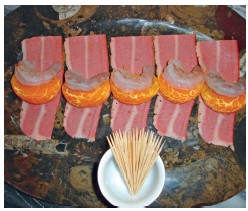
These Bacon-Shrimp Citrus Wraps, made with blood orange segments, are ready to roll.
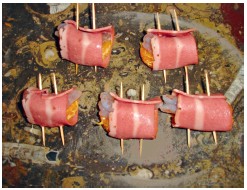
Rolled and pinned appetizers ready for the grill.
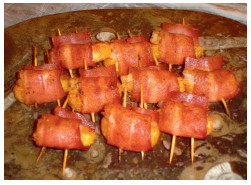
Bacon-Shrimp Citrus Wraps fresh from the grill.
Citrus Fire Chicken is a simple main dish that is quick and easy to prepare. Cut one boneless chicken breast per serving into long thin strips. Sauté the strips in coconut oil with one or more hot peppers of your choice and one chopped, seeded limequat or calamondin for every two breasts. Add a couple of spoonfuls of citrus marmalade near the end for some sweetness to balance the fire. Serve this as your meat course, alongside rice, or on top of a salad. Peeled, chopped blood oranges or chopped kumquats could also be used for the citrus. Hopefully your hot pepper bonsai will provide the fire.
My favorite appetizer, Bacon-Shrimp Citrus Wraps, is made with segmented blood oranges, although I’ve also used tangerine segments when I can’t wait for my blood oranges to get ripe. Use very ripe oranges with deep color for the best effect. Take one medium to large shelled and deveined shrimp along with one blood orange segment, wrap with a half strip of turkey bacon, and pin with one or two toothpicks. (Note: I use turkey bacon, not only because it is healthier than pork, but also because it is made from pre-cooked turkey and only needs to be browned. With pork bacon, the shrimp and citrus would be overcooked, if not burned, by the time the bacon was ready.) Spray or brush with olive oil and season to taste. I recommend a combination of powdered garlic, ginger, paprika, and lemon pepper. Cook on the grill, turning frequently. Depending on the heat, the appetizer will take ten to fifteen minutes to cook. You might spritz them with a little herbal or citrus wine while cooking, especially if the fire is hot. Finish with a glaze of your choice for the last two minutes, exposing the glaze to the heat briefly. I’ve used all kinds of prepared oriental sauces, even cocktail sauce, for the glaze. My favorite is a blend of Thai sweet chili sauce and either citrus marmalade or a fruit jam like apricot. I advise you to make twice as many of these appetizers as you think you’ll need. If you serve them at a dinner party and turn your back for two minutes, they’ll be gone.
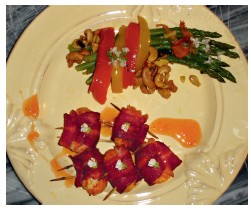
Grilled Bacon-Shrimp Citrus Wraps served alongside a sautéed orange asparagus dinner.
Dried figs are easy to find, but fresh figs are rare unless you live in a warm climate where they survive outdoors. I’ve never really cooked with figs, although when I started growing fig bonsai I saved and froze every fig until I had enough to create a vintage of fig wine. I serve them fresh, halved or quartered, on salads or as an edible garnish on a serving plate. My Kadota and Peter’s Honey figs are a beautiful golden yellow when cut, and my Celeste figs are a deep ruby red. Brown Turkey figs are a purple-brown color and larger than most other figs. Using figs of different colors as a garnish makes a beautiful presentation. When I serve them as an appetizer, I trim off the stem end and stuff a nugget of feta cheese inside. Small figs can be served whole after stuffing; larger ones can be halved or quartered, with a nugget of feta placed in each piece.
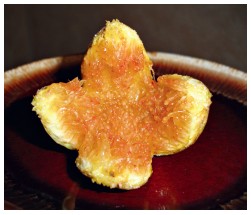
This Kadota fig got so ripe it opened like a flower.
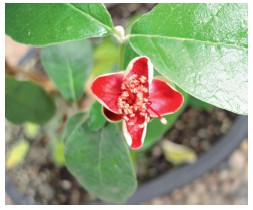
Pineapple guava flower petals are white on the outside and red on the inside but curl shortly after opening, hiding the red inside.
Strawberry and lemon guavas have tart skins and soft, sweet, white flesh when ripe. They also contain hard seeds a little larger than grape pips that are tough to remove without losing some of the tasty flesh. If the guavas are fresh, it’s probably best to just eat them and spit out the seeds. Guavas make a nice jelly when cooked down if the seeds are sieved or strained out before the pectin and sugar are added. I either eat my guavas fresh or ferment them into wine. My pineapple-guava bonsai flower every year but have never produced fruit; apparently they are not self-fertilizing. Pineapple guavas need some age to flower, but are worth growing for the flowers even without fruit. The large white petals are thick, fleshy and sweet, and are best picked from the tree and eaten fresh. They can be a unique edible garnish or topping on a salad.
While I have grown every plant variety mentioned in this book, some of them have never borne an edible crop for me. That doesn’t prevent them from being interesting bonsai to grow, and I still hope that perhaps with more age or experimentation they will bear fruit. Some are just small shrubs like Chilean guava, which provides a few tasty berries but not enough to make anything without saving several years’ worth of fruit in the freezer. Natal plums are tasty and produce fruit sporadically through the year, but I’ve never had enough of them to make anything substantial. Most edible-bonsai growers will have similar results, unless they have the space for a large bonsai or a group of several smaller bonsai of the same species. Most of these fruits are best enjoyed fresh right from the tree. Some fruits, like citrus, can flavor an entire dish, but perhaps the best use of a special, unique fruit is to pluck one off the bonsai to offer fresh to a guest who has never tasted a fresh fig, guava, or kumquat.
We create bonsai in order to share their beauty with others. With edible bonsai, that includes letting others experience the consumable part of the bonsai. When someone visits my greenhouse, if there is no fresh fruit to offer, I share fragrances of flowers like citrus or Natal plum, or I pluck a leaf from a rosemary or Costa Rican mint bush to hand them for aroma-therapy, or I have them simply touch my fragrant herbal bonsai with their hands and breathe in the fragrance. I have attended Bonsai Society shows where some exhibitors watch their prized specimens like hawks, and there are more signs saying ”Please Don’t Touch the Bonsai” than there are bonsai. I’ve brought large herbal bonsai, which grow so quickly that I could trim pieces of the bonsai to give away with damaging my specimen, to these shows, and encouraged people to come touch them and experience the fragrance. I’m afraid I created a fuss and attracted a crowd that interfered with foot traffic through the exhibit. You’ll find that people respond to the concept of approachable bonsai gardening with great interest. I wish you well as you amaze your friends with your bountiful bonsai!
